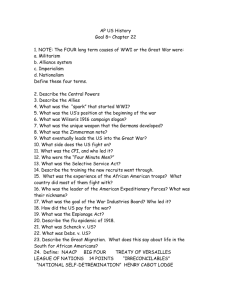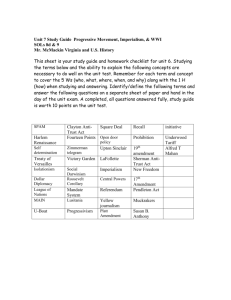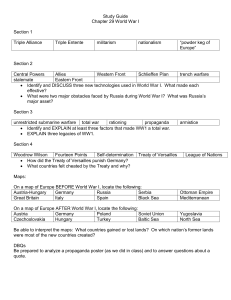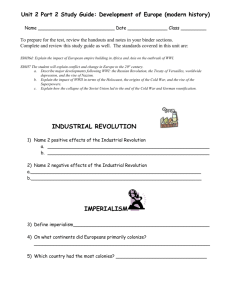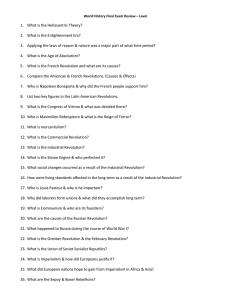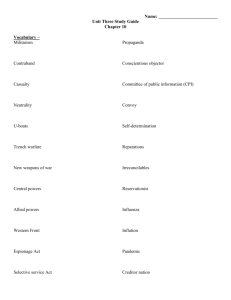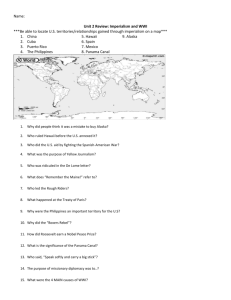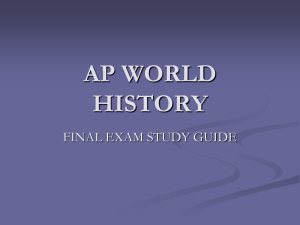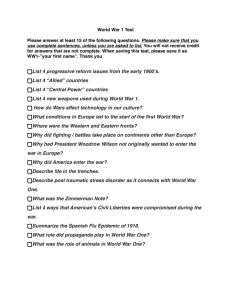Terms and Events
advertisement
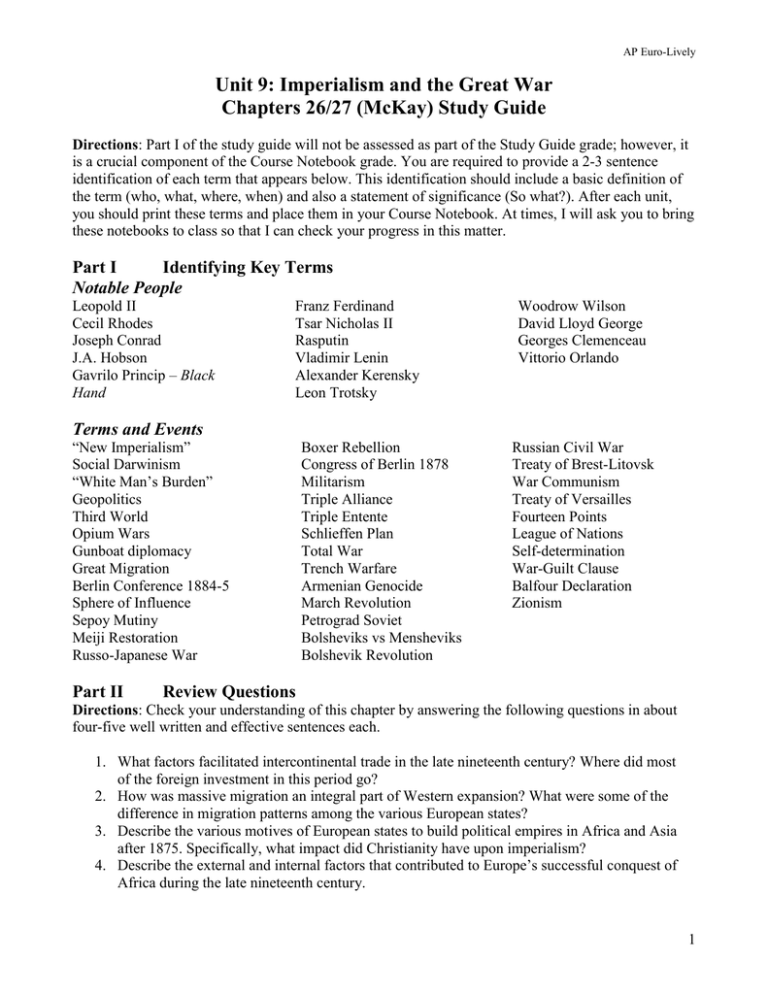
AP Euro-Lively Unit 9: Imperialism and the Great War Chapters 26/27 (McKay) Study Guide Directions: Part I of the study guide will not be assessed as part of the Study Guide grade; however, it is a crucial component of the Course Notebook grade. You are required to provide a 2-3 sentence identification of each term that appears below. This identification should include a basic definition of the term (who, what, where, when) and also a statement of significance (So what?). After each unit, you should print these terms and place them in your Course Notebook. At times, I will ask you to bring these notebooks to class so that I can check your progress in this matter. Part I Identifying Key Terms Notable People Leopold II Cecil Rhodes Joseph Conrad J.A. Hobson Gavrilo Princip – Black Hand Franz Ferdinand Tsar Nicholas II Rasputin Vladimir Lenin Alexander Kerensky Leon Trotsky Woodrow Wilson David Lloyd George Georges Clemenceau Vittorio Orlando Terms and Events “New Imperialism” Social Darwinism “White Man’s Burden” Geopolitics Third World Opium Wars Gunboat diplomacy Great Migration Berlin Conference 1884-5 Sphere of Influence Sepoy Mutiny Meiji Restoration Russo-Japanese War Part II Boxer Rebellion Congress of Berlin 1878 Militarism Triple Alliance Triple Entente Schlieffen Plan Total War Trench Warfare Armenian Genocide March Revolution Petrograd Soviet Bolsheviks vs Mensheviks Bolshevik Revolution Russian Civil War Treaty of Brest-Litovsk War Communism Treaty of Versailles Fourteen Points League of Nations Self-determination War-Guilt Clause Balfour Declaration Zionism Review Questions Directions: Check your understanding of this chapter by answering the following questions in about four-five well written and effective sentences each. 1. What factors facilitated intercontinental trade in the late nineteenth century? Where did most of the foreign investment in this period go? 2. How was massive migration an integral part of Western expansion? What were some of the difference in migration patterns among the various European states? 3. Describe the various motives of European states to build political empires in Africa and Asia after 1875. Specifically, what impact did Christianity have upon imperialism? 4. Describe the external and internal factors that contributed to Europe’s successful conquest of Africa during the late nineteenth century. 1 AP Euro-Lively 5. What distinguished the “new imperialism” (post-1880) from earlier forms of European expansion in the nineteenth century? 6. Describe the various non-Western responses to Western Imperialism. What is the difference between the traditionalist response and the modernist response? 7. For what reasons did western critics denounce imperialism? 8. In detail, describe the long-term causes of World War I. How did Bismarck’s system of alliances develop into rival blocs? 9. What impact did the Congress of Berlin (1878) have on the Balkan region? Who was bound to be the loser in the Balkans? 10. Based upon events in the early 20th century, why was the Balkans known as the “powder keg of Europe”? Describe the event that sparked this “powder keg” and caused the outbreak of World War I. 11. Analyze the social, political, and economic changes associated with the process of “total war” that took place across Europe during World War I. 12. For what reasons did the Germans adopt the Schlieffen Plan? Was it successful? Why or why not? 13. Did the war have any effect on the power of organized labor? On women in society? Explain! 14. In detail, describe the reasons for the outbreak of the March Revolution in 1917. Was the outbreak of revolution inevitable? 15. What were the soviets? What role did they play in the Bolshevik Revolution? 16. What was it about Lenin’s character that made him a successful revolutionary? Why were his ideas popular with peasants and urban workers? 17. Why did Kerensky and the provisional government fail? 18. What are the various reasons for the Red Army’s victory in the Russian Civil War? 19. Compare and contrast the Russian Revolutions of 1917 and the French Revolution of the late eighteenth century. 20. What happened to the Austro-Hungarian and Ottoman empires after 1918? 21. Compare and contrast the goals of Wilson, Lloyd George, and Clemenceau at the Versailles peace conference. 22. Unlike the relatively successful Congress of Vienna, the Treaty of Versailles is often seen as a major reason for World War II. Why? (Hint: How did the Versailles Treaty cause more problems than it actually solved?) Part III Chronological Awareness Directions: Place the following events in the correct chronological order. Provide the year of each event. Since the events are given to you in a sequence that is out of chronological order, please reorder the events correctly. In the event that one or more of the events listed below do not have a single year in which it took place, provide the appropriate date ranges. Rewrite this list in the correct chronological order, providing the year of the event, occurrence, or trend. 1. Sepoy Mutiny 2. Sinking of the Lusitania 3. First Battle of the Marne 4. Berlin Conference 5. Bolshevik Revolution 6. Treaty of Versailles 7. Completion of Suez Canal 2 AP Euro-Lively 8. Battle of Omdurman 9. Treaty of Brest-Litovsk 10. Treaty of Nanking Part IV Multiple Choice Practice Directions: Each of the questions or incomplete statements below is followed by five suggested answers or completions. Select the one that is best in each case, and then write the letter and the answer of your choice on your study guide. 1. Which of the following was NOT an underlying factor of the outbreak of World War I? a. Rivalries over colonial and commercial interests b. Overwhelming discontent with Europe’s royal families c. National aspirations of ethnic minority groups d. The rising influence of military leaders e. The growth of socialist labor movements 2. A crucial moment leading up to the outbreak of World War I occurred when a. Germany mobilized in response to Russia’s declaration of war against Serbia. b. France mobilized in response to Germany’s declaration of war against Britain. c. Austria mobilized in response to Russia’s declaration of war against Serbia. d. Russia mobilized in response to Austria’s declaration of war against Serbia. e. Britain mobilized in response to France’s declaration of war against Serbia. 3. Which statement regarding Italy’s participation in World War I is true? a. Previously allied with Germany, Italy chose to remain neutral. b. Previously allied with Russia and France, Italy chose to join with Germany. c. Previously allied with Germany, Italy chose to join with the Allied Powers. d. Previously allied with Britain and France, Italy chose to remain neutral. e. Previously allied with the Ottoman Empire, Italy chose to join with the Central Powers. 4. The concept of “Total War” that emerged during World War I included all of the following EXCEPT a. Expansion of civil liberties. b. Mass conscription. c. Planned economies. d. Centralization of government powers. e. Manipulation of public opinion. 5. In general, which of the following is most true of trade unions during World War I? a. Trade unions suffered greatly. b. Trade unions saw membership decrease. c. Trade unions were mostly ignored by government authorities. d. Trade unions did not cooperate with government authorities. e. Trade unions gained prestige and increased membership. 6. Which of the following was NOT a problem faced by the provisional government of Russia after the tsar abdicated in March 1917? a. The White Army forces under the leadership of Admiral Kolchak 3 AP Euro-Lively b. c. d. e. The Bolsheviks under the leadership of Vladimir Lenin. Peasant seizure of land. Army Order No. 1 A failed military offensive. 7. Great Britain’s reaction to the Sepoy Mutiny of 1857 was to a. Extend greater tolerance toward Indian customs and rule. b. Establish greater control via the East India Company. c. Exchange its trade rights in India for a greater share in the China trade. d. Withdraw its political presence from India. e. Enforce a series of oppressive laws separating the native population from the British colonials. 8. Why was it necessary for the Congress of Berlin (1878) to renegotiate the Treaty of San Stefano? a. Austria-Hungary wished to support Serbian independence. b. Since Russia had been the aggressor, its territorial claims were questionable. c. The treaty violated earlier agreements which only consenting nations could alter. d. Germany viewed Turkey as a valuable ally against Russia. e. Germany feared that both Great Britain and France would ally their interests with Russia. 9. Which of the following motives was of LEAST influence on late 19th century imperialism? a. Intellectual curiosity b. Humanitarianism c. Political competition d. Expansion of world markets e. Missionary zeal 10. The so-called “lifeline of the British empire” was a. India. b. South Africa. c. the Cape to Cairo railway. d. Australia and British Canada. e. the Suez Canal. Note: Incomplete study guides will receive a 10 point penalty. This will not be allowed to be made up via redo. Organize your time and work on your study guide a little bit at a time. Substantially incomplete study guides will be graded, but considered late, and only allowed to be redone up to 25 points. Study Guide Grading Rubric. 50 points. Review Questions (20 points) - 4 questions will be selected at random from those above. Each will be worth 5 points. Multiple Choice (10 points) - This section is worth 10 points. 1 point will be deducted for each incorrect response. Chronology (10 points) - This section is worth 10 point. Points will be deducted for each incorrect response. 4 AP Euro-Lively Overall Completion (10 points) - 10 points will be awarded for completion of all questions and parts. 5
